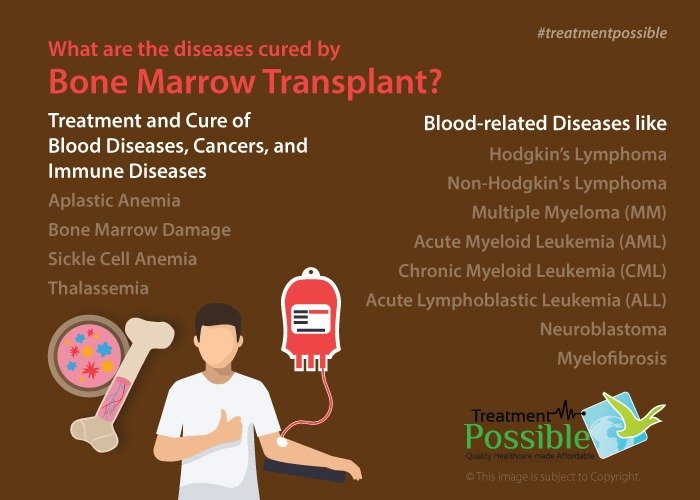What is Leukemia?
Leukemia is a type of blood cancer that usually involves the white blood cells which normally grows and divides in an orderly way, as per your body requirement. But in people with Leukemia, the bone marrow produces abnormal white blood cells, which do not function properly. Leukemia is a cancer of the body’s white blood cells that develops in the bone marrow and lymphatic system and then flows into the bloodstream. There are four types of leukemia which then classified into two categories:
-
Acute: Acute leukemia progress more rapidly and involve the immature cells, called stem cells.
-
Chronic: Chronic leukemia gradually worsens and develops in mature cells.
How do you get Leukemia?
In general, leukemia is thought to occur when some blood cells acquire changes (mutations) in their DNA. A DNA contains instructions that tell other cells what to do. Normally, the DNA will tell the cell to grow at a set rate and to die at a set time. But in leukemia, the mutations will tell the blood cells to continue growing and dividing.
When this happens, blood cell production divides too quickly and eventually crowd out the normal healthy blood cells in the bone marrow. This leads to a fewer healthy white blood cells, red blood cells and platelets, causing the symptoms of leukemia.
What are the Types of Leukemia?
The types of Leukemia are:
- Acute lymphocytic leukemia (ALL)
- Acute myelogenous leukemia (AML)
- Chronic lymphocytic leukemia (CLL)
- Chronic myelogenous leukemia (CML)
Request a Free Estimate

- Travel to India for Affordable and Advanced Healthcare
Acute Leukemia:
Acute Leukemia progresses quickly because they affect stem cells, called blasts, which divide rapidly—both normal blood cells and cancerous ones. The problem is that the abnormal cells invade the blood quickly because they do not stop dividing when they should. Since they are fast-growing, the acute leukemias spread to other organs such as the central nervous system. Many people with acute forms of leukemia experience symptoms of easy bleeding, bruising, fatigue, unintended weight loss, and frequent infections.
There are two types of Acute Leukemia:
-
Acute Lymphocytic (also called Lymphoblastic) Leukemia (ALL): ALL starts in stem cells called lymphoblasts. These cells can spread quickly through bone marrow. They crowd out other developing blood cells, including red blood cells, white blood cells (important for fighting infection), and platelets (important for blood clotting). Mature lymphocytes are responsible for making antibodies. ALL is one of the most common types. Both adults and children can get it. It is the most common leukemia in children. Acute Lymphocytic Leukemia grows quickly and requires immediate treatment. It can spread from the bone marrow to the brain.
-
Acute Myelogenous (also called Myeloid) Leukemia (AML): AML starts in stem cells called leukemic blasts. AML can spread quickly through bone marrow and decrease the production of healthy blood cells in all three types: white blood cells, red blood cells, and platelets. The loss of red blood cells will cause anemia, the loss of white blood cells leads to frequent and severe infections and the loss of platelets leads to easy bleeding. AML is a type of cancer that grows quickly and needs immediate treatment. AML is hard to treat, but can be cured in some cases. This type is common in adults.
About 75% of all childhood leukemias are ALL, with the rest being AML.
Chronic Leukemia:
In chronic leukemia, the abnormal cells are partly mature but appear to be normal. When these cells develop into leukemia cells, they cannot fight illness, and they survive longer than normal white blood cells, allowing them to build up in the blood.
These types of cancer progress slower than acute leukemias. They do not show any symptoms and people can live for many years after developing the disease. However, chronic leukemia does not respond to treatment and this makes it more difficult to cure.
There are two types of Chronic Leukemia:
-
Chronic Lymphocytic Leukemia (CLL): CLL does not show any symptoms until years after cancer starts. CLL develops from partly mature white blood cells called lymphocytes. It begins in the bone marrow and then flows into the blood. There are two types of CLL, one that grows slowly, and another that develops more quickly and is more serious. The stem cell that becomes CLL will be called a leukemic cell. Slow-growing CLL does not crowd out other developing blood cells and is less severe than the fast-growing form, and it may not need treatment for years. CLL is more common in adults.
-
Chronic Myelogenous Leukemia (CML) starts in myeloid cells but the abnormal cells grow slowly. The stem cell that develops into CML is a leukemic cell. Since CML is slow-growing leukemia, it does not crowd out other developing blood cells in the bone marrow. But it can also turn into an acute, fast-growing leukemia. This type of leukemia mainly affects adults. CML patients may have few or no symptoms for months or years before entering a phase in which the leukemia cells grow rapidly. The exposure to high doses of radiation can be one of the causes of CML.
Chronic leukemia is rare in children.
Want more clarification about medical expense & treatment plan?
Plan Your Leukemia Treatment In India
Get a Free Doctor's OpinionWhatapp UsWhat are the Causes and Risk factors for Leukemia?
The causes and risk factors may include the following:
- Having a family history of leukemia
- Smoking increases your risk of developing acute myeloid leukemia (AML)
- Genetic disorders such as Down syndrome
- Blood disorders, such as myelodysplastic syndrome (otherwise called “preleukemia”)
- If you had previous treatment for cancer with chemotherapy or radiation
- If you were exposed to high levels of radiation or chemicals such as benzene
What are the Leukemia Symptoms?
The Leukemia symptoms include the following:
- Excessive sweating, especially at night (called “night sweats”)
- Fatigue that does not go away with rest
- Unintentional weight loss
- Bone pain and tenderness
- Painless but swollen lymph nodes (especially in the neck and armpits)
- Enlargement of the liver or spleen
- Red spots on the skin called petechiae
- Bleeding and bruising easily
- Fever or chills
- Frequent infections
Leukemia can cause symptoms in organs that have been affected by cancer cells. For e.g, If Leukemia has spread to the central nervous system, then it can cause headaches, nausea and vomiting, confusion, loss of muscle control, and seizures.
How is Leukemia Diagnosed?
A physician will use blood tests, biopsies, and imaging tests to make a diagnosis. A complete blood count will determine the numbers of RBCs, WBCs, and platelets in the blood. Your blood is then examined under a microscope to check for the abnormal appearance of cells.
If the physician suspects leukemia, they may suggest a bone marrow test. A surgeon will extract bone marrow from the center of a bone, usually from the hip, using a long, fine needle. This will help them to identify the presence and type of leukemia.
How is Staging for Leukemia done?
Once leukemia is diagnosed, it will be staged. AML and ALL are staged based on the type of cell and how the cancer cells appear under the microscope.
- ALL and CLL are staged based on the WBC count during diagnosis.
- The presence of immature white blood cells, or myeloblasts, in the blood and bone marrow is also used to stage AML and CML.

What are the Treating Options for Leukemia?
Leukemia is usually treated by a hematologist-oncologist who is specialized in blood cancer and blood disorders. The treatment depends on the type and stage of cancer, the type of leukemia you have, and whether it has spread to other parts of your body or not. However, leukemia treatment involves one or more of the following:
-
Chemotherapy uses drugs to kill leukemia cells. Depending on the type of leukemia, you will need to take a single drug or a combination of different drugs.
-
Radiotherapy uses high-energy radiation to destroy leukemia cells and stop their growth. Radiation therapy uses X-rays to kill cancer cells, either to a specific area or to your entire body.
-
Biological or immune therapy uses treatments that help your immune system to recognize and attack cancer cells. Biological therapy with man-made drugs help the immune system to kill cancer cells, this is used mostly with CLL. Biological therapy with interferon, which is an injection of substances made in the immune system, this is used mostly with CML.
-
Targeted Therapy uses medications which take advantage of the weaknesses in the cancer cells.
-
Bone Marrow Transplant replaces diseased bone marrow with healthy bone marrow, either your own (called autologous transplantation) or from a donor (called allologous transplantation).
What is the Survival Rate of Leukemia Treatment?
The outcome for leukemia treatment depends on the type of cancer they have and their stage at diagnosis. If leukemia is diagnosed early, then the chances are higher of getting treated completely.
If not diagnosed early, the treatment will be focused on controlling the growth of cancer cells. You will need to attend follow-up sessions that may involve certain blood tests and a physical examination to monitor the growth of cancer and minimize the side effects. Therefore, regular treatment is necessary for blood cancer.
According to the National Cancer Institute (NCI):
- The five-year survival rate for ALL is 68.2%.
- The five-year survival rate for AML is 26.9%.
- The five-year survival rate for CLL is 83.2%.
- The five-year survival rate for CML is 66.9%.
Our Services
From Treatment To Recovery, We Are Always There With You!

Medical Visa Letter
We provide a Medical visa letter for which we require the scanned passport copies of the patient and attendant.

Arrange An Appointment With A Surgeon
We arrange for the appointment with the surgeon, confirm for the hospital room and operation theatre (if required)

Post Surgery Follow Up
We help you to fix your telephonic appointment for future follow-ups

Complimentary Pickup
We arrange for complimentary pickup and drop services from the airport.

All The Necessary Arrangements
We arrange for hospital admission, forex exchange, sim card and local assistance

No Need To Worry About Essential Expenses!
We help in sorting out the hospital bill, return ticket, medicines and other essential purchases.


